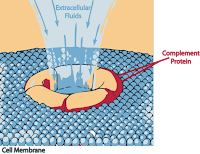Reviewer: S. Randhawa, M.D., Allergist/Immunologist and Assistant Professor at LSU (Shreveport) Department of Allergy and Immunology
Innate Immune System (click on the title for the full text).

The 2 arms of the immune system: innate immunity and adaptive immunity.

Overview of the innate immune system (a mind map).
Complement System
Complement system is a cascade of enzymes which leads to a membrane attack complex (MAC) which causes osmotic lysis of cells. Different fragments of the complement cascade act as inflammatory mediators.
There are 3 pathways for activation of complement:
CAM
Classical
Alternative
Mannose-binding lectin (MBL)

Mannose-binding lectin (MBL). Image source: Wikipedia.
The 3 pathways (CAM) converge at the point of cleavage of C3. Then C3b becomes an acceptor site for C5, and C5-9 form the membrane attacking complex (MAC). Thus, CAM leads to MAC:
CAM --> MAC

Classical and alternative complement pathways. Image source: Wikipedia.

C1 protein, showing subunits C1r, C1s, and the C1q tails. Image source: Wikipedia. Hereditary angioedema (HAE) is an autosomal dominant condition associated with episodic attacks of nonpitting edema. Patients with HAE have low levels of C1 inhibitor (a serine protease inhibitor). Edema is caused by unregulated generation of bradykinin.
MBL looks almost exactly like the "branching" C1 protein. The binding affinity of C1q decreases in the following order IgM, IgG3, IgG1, IgG2.
The likelihood of SLE development in complement deficiency: most common in C1q deficiency, then C4, and then C2.
HAE mnemonic:
1
C1 inhibitor is low
C1 q level is normal
11 chromosome
11 years is the mean age of onset
11 years before the diagnosis is made, on average
Classical pathway
C1
Cleaves
C4
Covalent bond to bacterial surface
Cleaves
C2
Complex C4b2a
C3
Convertase to MAC
C
Classical pathway
Complex Ag-Ab (IgG/M)
A
Alternative pathway
Adhesive cell walls
Antibody not needed for activation (different from classical pathway)
Click to see Wikipedia figures.
Alternative and MBL pathway
A
Alternative and MBL pathway
Antibody not needed for activation (different from classical pathway)
C3 - no receptor on any cell
C3b receptor - CD35 - CR1
C3a - small molecule
C3 continuously undergoes small scale cleavage in the plasma to C3b. This is called C3 tickover.
What is the rate-limiting step in the complement cascade?
C4. The liver can produce a finite amount of C4. In rare cases, when an angioedema attack is treated with large amounts of FFP, symptoms may worsen because of a temporary C4 depletion.
Complement receptors (CR) (click on the title for the full text).
C3 - no receptor on any cell
C3b receptor - CD35 - CR1
C3a - small molecule
C3 continuously undergoes small scale cleavage in the plasma to C3b. This is called C3 tickover.
B cell activation
Complement receptor CD21 (CR2) activates BCR if the antigen is opsonized by C3b component of the complement.
CR2-CD19-CD81 complex is expressed on the surface of B lymphocytes.
When CD21 (CR2) interacts with C3d, the complex is brought into the BCR. CD19 has an ITAM that is phosphorylated, thus recruiting Lyn to enhance phosphorylation.
What is the rate-limiting step in the complement cascade?
C4. The liver can produce a finite amount of C4. In rare cases, when an angioedema attack is treated with large amounts of FFP, symptoms may worsen because of a temporary C4 depletion.
Complement receptors (CR) (click on the title for the full text).
Chemotaxis
References
Allergy and Immunology MKSAP, 3rd edition.
Chapter 2. Innate immunity. Abbas et al: Cellular & Molecular Immunology, 6th Ed.
Related Reading
Medical Immunology Syllabus. Columbia University.
Anaphylaxis Due to Contaminated Heparin Causes Multiple Deaths, Trigger Found. Allergy Notes, 04/2008.
FIT Corner Q & A from 5th edition of Cellular and Molecular Immunology, edited by Abul K. Abbas and Andrew H. Lichtman. ACAAI, 2004.
Chapter 6: The Complement System, Part 1 and Part 2. Allergy and Immunology Review Corner: Chapter 6, Part 1 of Middleton’s Allergy Principles and Practice, 7th Edition, edited by N. Franklin Adkinson, et al. FIT Corner Q&A.
Mnemonics: Complement
Videos
Classical Pathway Complement System
Alternative Pathway Compliment System
The Complement System.
Complement Proteins
Published: 12/05/2007
Updated: 09/05/2010
C5a is the most potent mediator of basophil and cutaneous mast cell degranulation. C5a is chemotactic for neutrophils, eosinophils, monocytes, and basophils.
C3a is chemotactic for eosinophils only.
All of the following are correct pairings of complement deficiency and component of the complement system EXCEPT:
A. C2 or C4 deficiency with SLE-like syndrome
B. deficiency in the components of the alternative pathway of compliment with pyogenic bacterial infections
C. deficiency in the terminal components of complement with H. Influenzae infection
D. C1 inhibitor deficiency with angioedema
Answer: C. Deficiency in the terminal components of complement (C7-9) leads to Neisseria meningitidis infection.
References
Allergy and Immunology MKSAP, 3rd edition.
Chapter 2. Innate immunity. Abbas et al: Cellular & Molecular Immunology, 6th Ed.
Related Reading
Medical Immunology Syllabus. Columbia University.
Anaphylaxis Due to Contaminated Heparin Causes Multiple Deaths, Trigger Found. Allergy Notes, 04/2008.
FIT Corner Q & A from 5th edition of Cellular and Molecular Immunology, edited by Abul K. Abbas and Andrew H. Lichtman. ACAAI, 2004.
Chapter 6: The Complement System, Part 1 and Part 2. Allergy and Immunology Review Corner: Chapter 6, Part 1 of Middleton’s Allergy Principles and Practice, 7th Edition, edited by N. Franklin Adkinson, et al. FIT Corner Q&A.
Mnemonics: Complement
Videos
Classical Pathway Complement System
Alternative Pathway Compliment System
The Complement System.
Complement Proteins
Published: 12/05/2007
Updated: 09/05/2010

No comments:
Post a Comment